Related Research Articles
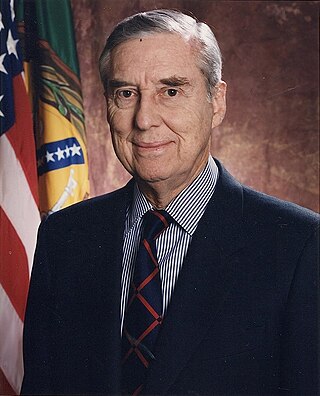
Lloyd Millard Bentsen Jr. was an American politician who was a four-term United States Senator (1971–1993) from Texas and the Democratic Party nominee for vice president in 1988 on the Michael Dukakis ticket. He also served as the 69th United States Secretary of the Treasury under President Bill Clinton.
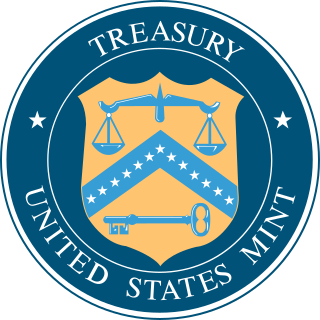
The United States Mint is a bureau of the Department of the Treasury responsible for producing coinage for the United States to conduct its trade and commerce,as well as controlling the movement of bullion. The U.S. Mint is one of two U.S. agencies that manufactures physical money. The other is the Bureau of Engraving and Printing,which prints paper currency. The first United States Mint was created in Philadelphia in 1792,and soon joined by other centers,whose coins were identified by their own mint marks. There are currently four active coin-producing mints:Philadelphia,Denver,San Francisco,and West Point.

The dollar coin is a United States coin with a face value of one United States dollar. Dollar coins have been minted in the United States in gold,silver,and base metal versions. Dollar coins were first minted in the United States in 1794.

The 50 State quarters was a series of circulating commemorative quarters released by the United States Mint. Minted from 1999 through 2008,they featured unique designs for each of the 50 US states on the reverse.

Michael Newbold Castle is an American lawyer and politician who served as the 69th Governor of Delaware from 1985 to 1992 and as the U.S. representative from Delaware's at-large congressional district from 1993 to 2011. He is a member of the Republican Party.
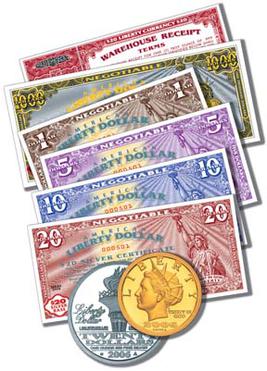
The American Liberty Dollar (ALD) was a private currency produced in the United States.
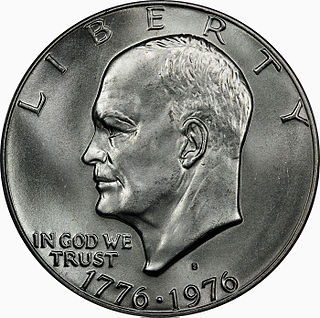
The United States Bicentennial coinage is a set of circulating commemorative coins,consisting of a quarter,half dollar and dollar struck by the United States Mint in 1975 and 1976. Regardless of when struck,each coin bears the double date 1776–1976 on the normal obverses for the Washington quarter,Kennedy half dollar and Eisenhower dollar. No coins dated 1975 of any of the three denominations were minted.

The Eisenhower dollar is a one-dollar coin issued by the United States Mint from 1971 to 1978;it was the first coin of that denomination issued by the Mint since the Peace dollar series ended in 1935. The coin depicts President Dwight D. Eisenhower on the obverse,and a stylized image honoring the 1969 Apollo 11 Moon mission on the reverse. Both sides were designed by Frank Gasparro,with the reverse based on the mission patch designed by astronaut Michael Collins. It is the only large-size U.S. dollar coin whose circulation strikes contained no silver.

The Mercury dime is a ten-cent coin struck by the United States Mint from late 1916 to 1945. Designed by Adolph Weinman and also referred to as the Winged Liberty Head dime,it gained its common name because the obverse depiction of a young Liberty,identifiable by her winged Phrygian cap,was confused with the Roman god Mercury. Weinman is believed to have used Elsie Stevens,the wife of lawyer and poet Wallace Stevens,as a model. The coin's reverse depicts a fasces,symbolizing unity and strength,and an olive branch,signifying peace.

The American Silver Eagle is the official silver bullion coin of the United States.
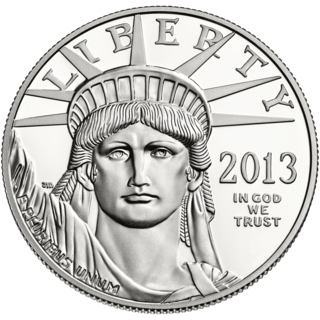
The American Platinum Eagle is the official platinum bullion coin of the United States. In 1995,Director of the United States Mint Philip N. Diehl,American Numismatic Association President David L. Ganz,and Platinum Guild International Executive Director Jacques Luben began the legislative process of creating the Platinum Eagle. After over two years of work,the 99.95% fine platinum coins were released by the United States Mint in 1⁄10,1⁄4,1⁄2 and 1 troy oz denominations. In late 2008,the fractional denominations were discontinued,leaving only the one ounce denomination. The Platinum Eagle is authorized by the United States Congress,and is backed by the United States Mint for weight,content,and purity.

The Peace dollar is a United States dollar coin minted for circulation from 1921 to 1928 and 1934 to 1935,and beginning again for collectors in 2021. Designed by Anthony de Francisci,the coin was the result of a competition to find designs emblematic of peace. Its obverse represents the head and neck of the Goddess of Liberty in profile,and the reverse depicts a bald eagle at rest clutching an olive branch,with the legend "Peace". It was the last United States dollar coin to be struck for circulation in silver.
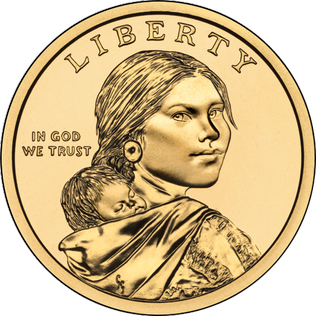
The Sacagawea dollar is a United States dollar coin introduced in 2000,but subsequently minted only for niche circulation from 2002 onward. The coin generally failed to meet consumer and business demands. It is still generally accepted in circulation.

The Walking Liberty half dollar is a silver 50-cent piece or half dollar coin that was issued by the United States Mint from 1916 to 1947;it was designed by Adolph A. Weinman,a well-known sculptor and engraver.
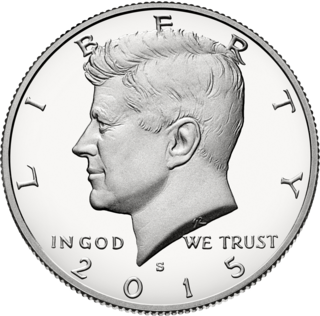
The Kennedy half dollar,first minted in 1964,is a fifty-cent coin issued by the United States Mint. Intended as a memorial to the assassinated 35th president of the United States John F. Kennedy,it was authorized by Congress just over a month after his death. Use of existing works by Mint sculptors Gilroy Roberts and Frank Gasparro allowed dies to be prepared quickly,and striking of the new coins began in January 1964.
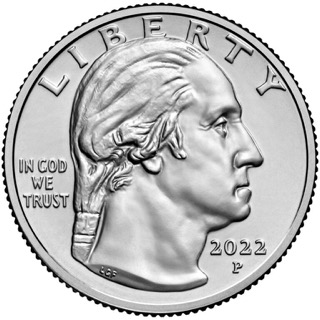
The Washington quarter is the present quarter dollar or 25-cent piece issued by the United States Mint. The coin was first struck in 1932;the original version was designed by sculptor John Flanagan.

The United States dollar is the official currency of the United States and several other countries. The Coinage Act of 1792 introduced the U.S. dollar at par with the Spanish silver dollar,divided it into 100 cents,and authorized the minting of coins denominated in dollars and cents. U.S. banknotes are issued in the form of Federal Reserve Notes,popularly called greenbacks due to their predominantly green color.

The Texas Centennial half dollar was a commemorative fifty-cent piece struck by the United States Bureau of the Mint for collectors from 1934 to 1938. It features an eagle and the Lone Star of Texas on the obverse,while the reverse is a complex scene incorporating the winged goddess Victory,the Alamo Mission,and portraits of Texan founding fathers Sam Houston and Stephen F. Austin,together with the six flags over Texas. Proposed by the American Legion's Texas Centennial Committee as a fundraising measure for the 100th anniversary of Texas independence from Mexico,the coin's issue was approved by Congress in 1933,ending a multi-year pause on new commemorative issues under the Hoover administration. It was designed by sculptor Pompeo Coppini,previously the designer of several Texan public monuments. Rough models of the coin were approved by the committee in May 1934,but rejected by the United States Commission of Fine Arts,who viewed the design as crowded and overly-complicated. A compromise was reached,and the coin entered production at the Philadelphia Mint in October 1934.
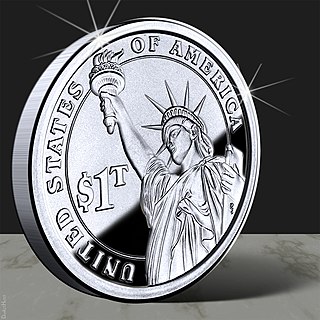
The trillion-dollar coin is a concept that emerged during the United States debt-ceiling crisis of 2011 as a proposed way to bypass any necessity for the United States Congress to raise the country's borrowing limit,through the minting of very high-value platinum coins. The concept gained more mainstream attention by late 2012 during the debates over the United States fiscal cliff negotiations and renewed debt-ceiling discussions. After reaching the headlines during the week of January 7,2013,use of the trillion-dollar coin concept was ultimately rejected by the Federal Reserve and the Treasury.

The Susan B. Anthony dollar is a United States dollar coin minted from 1979 to 1981,when production was suspended due to poor public acceptance,and then again in 1999. Intended as a replacement for the larger Eisenhower dollar,the new smaller one-dollar coin went through testing of several shapes and compositions,but all were opposed by the vending machine industry,a powerful lobby affecting coin legislation. Finally,a round planchet with an eleven-sided inner border was chosen for the smaller dollar.
References
- ↑ Network World, April 20, 1987, p. 3
- ↑ Greenhouse, Steven (August 25, 1993). "New York Times, Resignations at Treasury Raise the Question Is Bentsen Next". The New York Times. Retrieved January 21, 2012.
- ↑ Greenhouse, Steven (April 12, 1993). "New York Times, Executive Brief: The Treasury Department; Bentsen Remembers Way Around the Hill". The New York Times. Retrieved January 21, 2012.
- ↑ "The United States Mint, About the Mint". Usmint.gov. Retrieved January 21, 2012.
- 1 2 ""Fast Company", Fast Agency, Slow Government, November 30, 1999". Fastcompany.com. November 30, 1999. Archived from the original on September 17, 2008. Retrieved January 21, 2012.
- 1 2 3 4 5 6 7 ""CIO" magazine, The New Realm of the Coin; April 20, 1999". Cio.com.au. Archived from the original on October 19, 2016. Retrieved January 21, 2012.
- ↑ "Archived copy" (PDF). Archived from the original (PDF) on 2012-09-21. Retrieved 2013-07-03.
{{cite web}}: CS1 maint: archived copy as title (link) - 1 2 "Fast Company, Mint Condition, November 30, 1999". Fastcompany.com. November 30, 1999. Retrieved January 21, 2012.
- ↑ "The Best e-Business No One Has Heard Of, ClickZ, November 13, 1999". Clickz.com. 13 November 2000. Retrieved January 21, 2012.
- ↑ "Wall Street Journal, Customer Satisfaction: Survey Measures Satisfaction With Federal Services, 12/13/1999, Page A2". Cfigroup.com. Archived from the original on March 10, 2012. Retrieved January 21, 2012.
- ↑ Almer, Ellen (January 30, 2000). "New York Times, FIVE QUESTIONS: FOR PHILIP N. DIEHL; Putting a Shine on a Dollar That Jingles in Your Pocket, January 30, 2000". The New York Times. Retrieved January 21, 2012.
- ↑ "U.S. Mint Says Dollar Coin Successful, March 29, 2000". Associated Press. March 29, 2000. Retrieved January 27, 2014.
- ↑ "A trillion-dollar-coin idea takes off, and a former head of the U.S. Mint doesn't see why it shouldn't | Capital New York". Archived from the original on 2013-07-03. Retrieved 2013-07-03.
- ↑ "What's Up With The Trillion Dollar Coin?". CBS News. Retrieved February 16, 2013.
- ↑ "Former Head of U.S. Mint: The Platinum Coin Option Would Work". The Washington Post . Retrieved February 16, 2013.
- ↑ "The 13 People Who Can Order a 1 Trillion Dollar Coin". TheStreet. 9 January 2013. Retrieved February 16, 2013.
- ↑ "Mint The Coin: Former Mint Director Philip Diehl Explains Why The Trillion Dollar Coin Law Would Work". Business Insider. Retrieved February 16, 2013.
- ↑ "Could a $1 Trillion Coin Fix the National Debt?". MSN. Archived from the original on January 23, 2013. Retrieved February 16, 2013.
- ↑ "Former U.S. Mint Chief Rebuts the Mint the Coin Skeptics". Slate. 10 January 2013. Retrieved February 16, 2013.
- ↑ ""Los Angeles Times" March 24, 2000". Articles.latimes.com. March 15, 1988. Retrieved January 21, 2012.
- ↑ "News | U.S. Mint".
- ↑ "China Turns to Gold: Greater risk of instability can only increase the precious metal's luster". The Wall Street Journal. August 13, 2013. Retrieved January 28, 2014.
- ↑ "Wall Street Waits On Washington". Institutional Investor. October 3, 2013. Archived from the original on September 24, 2015. Retrieved January 28, 2014.
- ↑ "Advertising Age, The Marketing 100, June 26, 2000". Adage.com. June 26, 2000. Retrieved January 21, 2012.
- ↑ "ASPA's PAL Newsletter - April 2000". Archived from the original on 2014-02-01. Retrieved 2013-07-03.
- ↑ "Faith and Politics Institute". Faithandpolitics.org. Retrieved January 21, 2012.
- ↑ Jackson, Sharon (October 14, 2010). "Austin College". Austincollege.edu. Retrieved January 21, 2012.
- ↑ Clines, Francis X. (February 28, 2000). ""New York Times", PUBLIC LIVES; Sharing a Nation's History and Culture, a Coin at a Time, February 28, 2000". The New York Times. Retrieved January 21, 2012.
- ↑ McAllister, Bill. "The Washington Post, Director Institutes Big Change at U.S. Mint, December 7, 1998". Highbeam.com. Archived from the original on November 5, 2012. Retrieved January 21, 2012.
- ↑ John Wiley and Sons, 2007
- ↑ National Public Radio (NPR)
